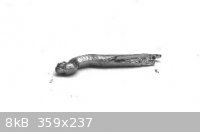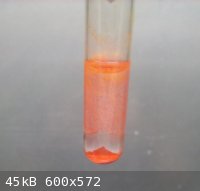Magpie
lab constructor
    
Posts: 5939
Registered: 1-11-2003
Location: USA
Member Is Offline
Mood: Chemistry: the subtle science.
|
|
polymorphism
Here is what I think is a dramatic example of polymorphism. The first picture is that of natural stibnite, which I believe is quite pure Sb2S3. It's
crystral structure is rhombic. The second picture is also of Sb2S3, but its structure is amorphous. The amorphous red-orange material was made
directly from the stibnite crystal.

[Edited on 25-4-2009 by Magpie]

|
|
|
Sedit
International Hazard
    
Posts: 1939
Registered: 23-11-2008
Member Is Offline
Mood: Manic Expressive
|
|
Magpie, can you tell us how the orange stibnite was created?
A full write up would be nice if you can.
I enjoy these form of materials.
Knowledge is useless to useless people...
"I see a lot of patterns in our behavior as a nation that parallel a lot of other historical processes. The fall of Rome, the fall of Germany — the
fall of the ruling country, the people who think they can do whatever they want without anybody else's consent. I've seen this story
before."~Maynard James Keenan
|
|
|
Magpie
lab constructor
    
Posts: 5939
Registered: 1-11-2003
Location: USA
Member Is Offline
Mood: Chemistry: the subtle science.
|
|
| Quote: |
Magpie, can you tell us how the orange stibnite was created?
|
Yes, it's very easy:
1. Grind up a little stibnite to a powder in a mortar. It's quite soft.
2. Add a smidgen (~ 25 mg) of this powder to a small test tube.
3. Add ~ 1 mL of 6M HCl and stir. Heat the mixture in a hot water bath until the powder is dissolved. You will see tiny bubbles of H2S evolving.
4. Add 2-3 drops of 5% thioacetamide and place in the hot water bath. Within seconds the clear solution will turn a beautiful red-orange!
Sb2S3 + 6H+ +8Cl- ---> 2[SbCl4]- + 3H2S(g)
Note 1: The 5% thioacetamide generates H2S in a warm acidic solution. Another source of H2S could be used if necessary. 5% thioacetamide is just a
very convenient source of H2S. I highly recommend it.
Note 2: If a 1/8" piece of aluminum wire is added to the clear solution of dissolved stibnite in "3." above and then placed in the hot water bath
great quantities of hydrogen will be generated and black flakes of antimony will appear.
Note 3: All this is from the qualitative analysis testing for antimony in the Group II cations.
Have fun 
[Edited on 25-4-2009 by Magpie]
|
|
|
pyrochem
Harmless

Posts: 21
Registered: 1-1-2006
Location: United States
Member Is Offline
Mood: No Mood
|
|
Woelen's site <a href="http://woelen.homescience.net/science/chem/exps/raw_material/sb2s3.html">lists</a> a way to make yellow
Sb<sub>2</sub>S<sub>3</sub> by dissolving stibnite in HCl and dumping the resulting solution in water. He claims it is
hydrated, but doesn't seem to have any proof.
Other sources* describe a number of different preparations of amorphous Sb<sub>2</sub>S<sub>3</sub> ranging from yellow to
red, with the color variable on heating. It is certainly an interesting group of compounds.
HgS does something similar, with cinnabar (trigonal) being red, and hypercinnabar (hexagonal) and metacinnabar (isometric) being black.
*See <a href="http://www.archive.org/stream/inorganiccolloid031247mbp/inorganiccolloid031247mbp_djvu.txt">here</a> (long; search for
"antimony sulfide pigments") and some of the papers cited within
EDIT by woelen: Changed link to my site such that it works again.
[Edited on 12-6-12 by woelen]
|
|
|